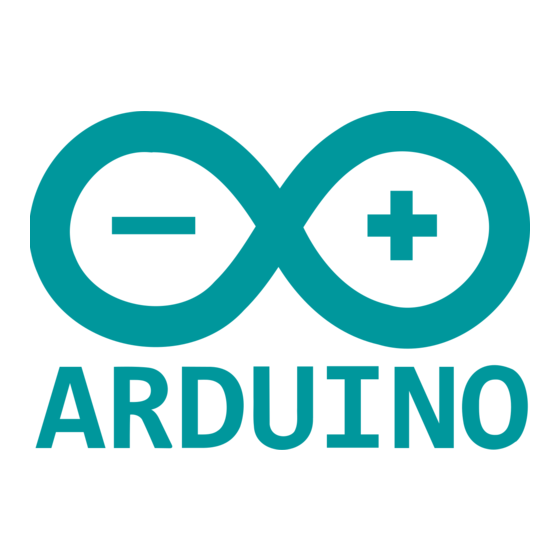
Table of Contents
Advertisement
Quick Links
Arduino® Alvik
Product Reference Manual
SKU: AKX00066
Description
Arduino® Alvik is a powerful and versatile robot specifically designed for programming and STEAM education.
Powered by the Arduino® Nano ESP32, Alvik offers diverse learning paths through different programming
languages including MicroPython, Arduino C, and block-based coding; enabling different possibilities to explore
Robotics, IoT and AI.
Target areas:
Maker, Education, MicroPython, Robotics
1 / 17
Arduino® Alvik
Modified: 03/05/2024
Advertisement
Table of Contents

Summary of Contents for Arduino Alvik AKX00066
- Page 1 SKU: AKX00066 Description Arduino® Alvik is a powerful and versatile robot specifically designed for programming and STEAM education. Powered by the Arduino® Nano ESP32, Alvik offers diverse learning paths through different programming languages including MicroPython, Arduino C, and block-based coding; enabling different possibilities to explore Robotics, IoT and AI.
-
Page 2: Table Of Contents
2.3 Power Supply 2.3.1 Robot's Battery 2.3.2 ON/OFF Power Switch 3 Device Operation 3.1 Getting Started - MicroPython 3.2 Getting Started - Arduino IDE 3.3 Getting Started - Arduino Cloud 3.4 Sample Sketches 3.5 Online Resources 4 Product Compliance 4.1 Certifications Summary 4.2 Declaration of Conformity CE DoC (EU) -
Page 3: Features
Feature Description Alvik on-board STM32 Arm® Cortex®-M4 32 Bit Core Alvik Main Arduino® Nano ESP32 Controller Connectivity Wi-Fi®, Bluetooth® LE RGB Color detection, Distance ToF 8x8 Array - up to 350 cm, IMU - 6 degree, 3x Line follower, Sensors... -
Page 4: Related Accessories (Included)
Product page Datasheet STM32F411RC Link Link Arduino® Nano ESP32 Link Link 1.4 Sensors Alvik comes with a large number of onboard sensors, from color detection to distance sensors or inertial measurement units, all of which are listed in the following table:... -
Page 5: Motors
Arduino® Alvik 1.5.1 Motors Alvik is a differential robot driven by two independent DC motors with magnetic relative encoders: Alvik's DC Motor Technical Specs The motors have the following technical specifications: Description Information Operating Voltage 6 VDC No load Current... -
Page 6: Rgb Leds
Arduino® Alvik 1.5.2 RGB LEDs Alvik has two fully programmable RGB LEDs named DL1 and DL2 at its top. Description Information RGB LED Left RGB LED Right 1.6 Connectors & Communication Protocols The robot is compatible with the following communication protocols:... -
Page 7: Functional Overview
The main parts of the robot are the following: Alvik's main part from top to bottom (left) and bottom to top (right) Part Quantity Details Arduino® Nano ESP32 Main controller of the robot Main PCB Main PCB of the robot STM32 Arm® Cortex®-M4... - Page 8 Arduino® Alvik Part Quantity Details Qwiic Connector I2C Qwiic Connector to extend robot capabilities Servomotor Connector 3-pins connector to attach servomotors 18650 Li-Ion Battery Battery of the robot Main Chassis Main chassis of the robot made in plastic Plastic support to hold the motor in place, a screwdriver is required to...
-
Page 9: Block Diagram
Arduino® Alvik 2.2 Block Diagram The following block diagram describes the main blocks of the robot from a hardware point of view: Alvik's Block Diagram 9 / 17 Arduino® Alvik Modified: 03/05/2024... -
Page 10: Power Supply
Arduino® Alvik 2.3 Power Supply The power distribution in the robot is explained by the following diagram: Power Tree Diagram There are three levels of power inside the robot: Level Description +3V7 From the battery, the reference level is 3.7 V but it can goes from 3.0 V to 4.2 V... -
Page 11: Robot's Battery
Arduino® Alvik 2.3.1 Robot's Battery Alvik is powered by a single 18650 Li-Ion Battery protected by a battery cover at the bottom of the product which can be opened with a Phillips screwdriver. The battery is designed to be easily replaceable at any time so the robot can be used without interruptions in educational environments. -
Page 12: On/Off Power Switch
Arduino® Alvik 2.3.2 ON/OFF Power Switch The power of the robot is located by a simple ON/OFF switch located on the top of the robot at the low right corner. Alvik's Power Switch 12 / 17 Arduino® Alvik Modified: 03/05/2024... -
Page 13: Device Operation
To connect the Alvik robot to your computer, you will need a USB-C® cable. 3.2 Getting Started - Arduino IDE If you want to program your Alvik robot while offline you need to install the Arduino® Desktop IDE [2]. To connect the Alvik robot to your computer, you will need a USB-C® cable. -
Page 14: Product Compliance
4.3 Declaration of Conformity to EU RoHS & REACH 211 01/19/2021 Arduino boards are in compliance with RoHS 2 Directive 2011/65/EU of the European Parliament and RoHS 3 Directive 2015/863/EU of the Council of 4 June 2015 on the restriction of the use of certain hazardous substances in electrical and electronic equipment. -
Page 15: Conflict Minerals Declaration
Arduino® Alvik 4.4 Conflict Minerals Declaration As a global supplier of electronic and electrical components, Arduino is aware of our obligations with regards to laws and regulations regarding Conflict Minerals, specifically the Dodd-Frank Wall Street Reform and Consumer Protection Act, Section 1502. Arduino does not directly source or process conflict minerals such as Tin, Tantalum, Tungsten, or Gold. -
Page 16: Company Information
Important: The operating temperature of the EUT can’t exceed 85℃ and shouldn’t be lower than -40 ℃. Hereby, Arduino S.r.l. declares that this product is in compliance with essential requirements and other relevant provisions of Directive 201453/EU. This product is allowed to be used in all EU member states. -
Page 17: Revision History
Arduino® Alvik 7 Revision History Date Revision Changes 24/04/2024 First Release 17 / 17 Arduino® Alvik Modified: 03/05/2024...


Need help?
Do you have a question about the Alvik AKX00066 and is the answer not in the manual?
Questions and answers